eliza
now browsing by tag
16x20
19th
24x36
abstract
acrylic
american
antique
artist
artwork
blue
canvas
century
contemporary
decor
female
fine
flowers
frame
framed
french
girl
hand
impressionism
impressionist
landscape
large
life
modern
nude
original
paint
painted
painting
paintings
peter
portrait
rare
scene
seascape
signed
still
stretched
vintage
wall
woman
Posted by: admin | on October 7, 2020
C1900 Mount Hood Landscape Painting By Oregon Artist Eliza Barchus. Signed

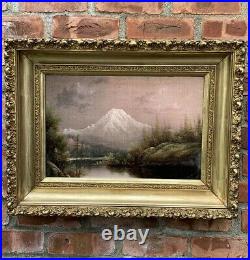
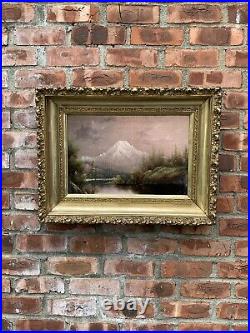


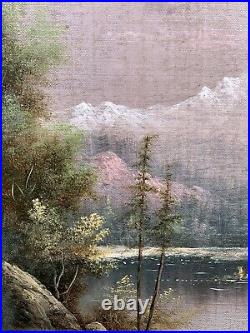
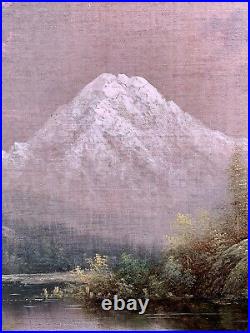
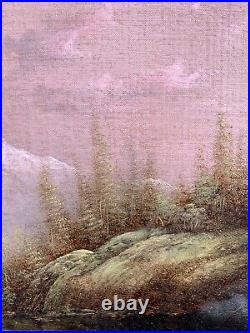
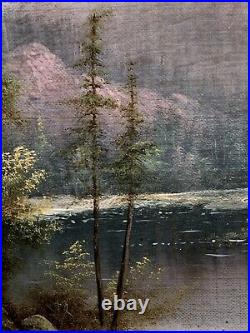
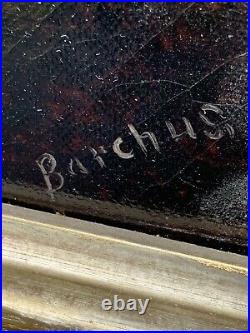
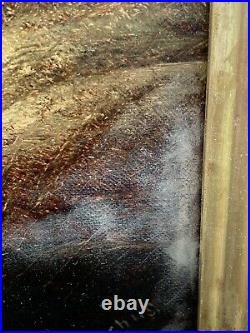
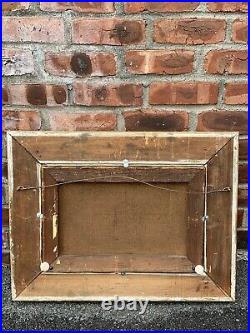


For sale is an original oil on canvas painting by the well known Portland Oregon landscape painter ELIZA ROSANNA BARCHUS (1857 – 1959). Known for capturing scenes throughout the Pacific North West, here she captures an image that she painted numerous versions of throughout her career, a stunning view of Mount Hood. This appears to be a depiction of Mount Hood probably near dusk with the white snowcapped mountain peak appearing to illuminate from the pink hue of a pacific northwest evening. In the foreground is a slow meandering River. Probably the Columbia River. Signed by the artist lower right corner. Condition: Seems to have been over varnished. Has surface grime under varnish. Needs a proper cleaning. Varnish bloom lower right. Framed in its original period gesso molded gold gilded picture frame. Framed – 19 3/4 x 25 3/4. Canvas – 12 x 18. ELIZA ROSANNA BARCHUS (1857 – 1959). Eliza Rosanna Lamb was born into the life of the raw Wild West in 1857. Her family generally led a nomadic life, frequently moving from town to town by wagon in search of work. For a period of time, her stepfather (her father died soon after she was born) led a colorful life as a US Deputy Marshal under “Wild Bill” Hickok. While a harsh childhood environment to be raised in, she learned the value of hard work, and which she would draw upon throughout her later life. In 1880, at the age of 22, she moved to Portland, Oregon, with her second new husband, John Barchus. That is unknown, but we are grateful that she did! Settling in Portland was her first opportunity to lay down roots. It is likely that she had always dreamed of being an artist. Now, her husband likely gave her the encouragement and resources she needed to fulfill that desire. So in 1884 Barchus took what were probably her only lessons in painting. While Portland already supported several instructors of art, she chose to study under William S. Parrott, likely because she admired his work, both in subject matter – local landscape – and artistic style. She adopted many of his methods, resulting in her early work being quite similar to his. Even today,’Barchus school’ or’Parrott school’ are frequently used terms to describe paintings by turn-of-the-century Oregon artists that align with their style. Within two years of her first lesson, Eliza commenced upon an art career that would ultimately span 50 years. In fact, by 1886 she had become an art instructor herself, advertised in The Oregonian daily newspaper that she had opened painting classes for young women, offering them at the “reduced rate of 50 cents” per lesson. She also began submitting her work at local art fairs, including the Annual Portland Mechanics Fair held each fall. A newspaper reference of Mrs. Barchus’s (sic) specimens will be seen at the fair indicates that she participated in the 1886 Fair. However, it was not until the next year that she hit gold earning the top prize for one of her landscape paintings! She was justifiably proud of her accomplishment. She later had the dime-size medal incorporated into a necklace, which can be seen in early photographs of the artist. In 1888 she was again recognized for her entries at the Fair with a silver medal. With back-to-back medal honors, and local encouragement, Barchus decided to submit an entry to National Academy of Design’s 1890 fall show in New York City. In route to the exhibition, Barchus had a chance encounter in Chicago with Henry Pittock (who later built the Pittock Mansion). He gave her encouragement for her journey and wish of success. At 32 years of age and just six years after starting her career, Barchus had now exhibited at one of America’s most prestigious art association. While Barchus was establishing herself as an artist, family commitments were also growing. Two children were born in the early 1890’s, which undoubtedly demanded her maternal attention. Additionally, her husband’s health began to deteriorate from Brights disease (a kidney ailment), and he died in 1899. Therefore, her talent in painting soon became the sole livelihood for the family. At a time when most women did not work, Barchus became a very adept and enterprising businesswoman. Remarkably, starting in 1891, she arranged for six homes to be built for her family in over a span of about twenty years. Construction costs were frequently paid by barter of her paintings rather than cash. Four of these southeast Portland homes are still in use today. Her savvy was not limited to domestic activities. She was a keeper of a downtown Portland art studio during this period. Her first studio was in the prominent Dekum building and later moved to the Multnomah building. Additionally, she arranged to have examples of her work displayed at other business establishments, including the local cigar & newspaper concessionaire B. Rich in at the famous Portland Hotel when it opened in 1890. With the growing need to support a family, and to assure enough supply of paintings for her flourishing tourist sales, Barchus began to produce standard sizes of popular northwest scenery in assembly-line type fashion. A collection of similarly unfinished paintings illustrate that she would work on ten or more paintings of a single scene at the same time: first painting the sky, then the background, and then moving toward the foreground with various layers of paint, likely letting each previous effort dry before beginning the next. She now reduced the detail elements that her earlier paintings had and a the “‘Barchus'” style developed appeared in her work. Popular scenes included the tremendous geologic formations of the region: local mountains Mount Hood, Mount Rainier, Mount St. Helens, and Mount Three Sisters, Multnomah Falls, Rooster Rock and Crater Lake. At arguably the peak of her career, Portland played host to the world with the 1905 Lewis and Clark Centennial Exposition and Oriental Fair. Barchus obtained a concessionaire’s booth to sell paintings in the fair grounds. These lithographs later evolved into successful postcard sales for many years afterwards. At the end of the Fair, Barchus again earned recognition by being awarded a the gold medal for the best collection of paintings of Pacific Coast scenery. Helen Barchus was primarily a studio painter and used photographs or literary descriptions as the source of many of her compositions. However, she did enjoy to traveling and such trips tended to be for the purpose of painting. The normal output of such a trip for an artist would typically be sketches that would later be used to complete finished oils upon return to the studio. However, it does not appear that Barchus produced sketches as none have been located. Therefore, it can be assumed that she completed paintings while on these trips, which she used for subsequent paintings. This would explain the large variety of scenery still intact in the artist’s collection at the time she finally laid down her brushes and pallet in the mid 1930’s. Remarkably, Barchus found time for leisurely pursuits. One was writing poetry. These covered a variety of topics, including war, friendship, and of course, nature’s beauty. Many she copyrighted, sometimes using her maiden name of Rosanna Lamb as a pseudonym – Rosanna Lamb. She incorporated some of these creative writings incorporated into her advertising material that promoted the sale of paintings. By the late 1920’s Barchus was in her 70’s. Her eyesight began to fail her and arthritis progressively became a problem. The quality of her paintings correspondingly suffered from crude execution of brush stroke and lack of color blending. By the mid 30’s she acknowledged that her facilities would no longer enable her to continue painting. After fifty years, and literally thousands of paintings- possibly as many as 7,500, she quietly laid down her pallet and brushes. She died several years later, in 1959, at the age of 102. The item “C1900 Mount Hood Landscape Painting By Oregon Artist Eliza Barchus. Signed” is in sale since Thursday, May 2, 2019. This item is in the category “Art\Paintings”. The seller is “upstatetreasures14″ and is located in Kingston, New York. This item can be shipped to United States, Canada, United Kingdom, Denmark, Romania, Slovakia, Bulgaria, Czech republic, Finland, Hungary, Latvia, Lithuania, Malta, Estonia, Australia, Greece, Portugal, Cyprus, Slovenia, Japan, China, Sweden, South Korea, Indonesia, Taiwan, South africa, Thailand, Belgium, France, Hong Kong, Ireland, Netherlands, Poland, Spain, Italy, Germany, Austria, Bahamas, Israel, Mexico, New Zealand, Singapore, Switzerland, Norway, Saudi arabia, United arab emirates, Qatar, Kuwait, Bahrain, Croatia, Malaysia, Brazil, Chile, Colombia, Costa rica, Panama, Trinidad and tobago, Guatemala, Honduras, Jamaica, Barbados, Bangladesh, Bermuda, Brunei darussalam, Bolivia, Ecuador, Egypt, French guiana, Guernsey, Gibraltar, Guadeloupe, Iceland, Jersey, Jordan, Cambodia, Cayman islands, Liechtenstein, Sri lanka, Luxembourg, Monaco, Macao, Martinique, Maldives, Nicaragua, Oman, Peru, Pakistan, Paraguay, Reunion, Viet nam, Uruguay, Philippines.
- Medium: Oil
- Subject: Mount Hood
- Date of Creation: 1900-1949
- Originality: Original
- Listed By: Dealer or Reseller
- Region of Origin: Portland Oregon
- Painting Surface: Canvas
- Artist: Eliza Barchus
- Features: Signed
- Size: Medium (up to 36in.)


 D5 Creation
D5 Creation